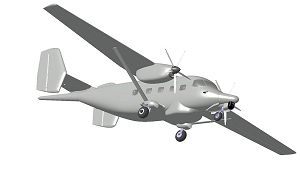Technical data
| Wing Span | 22,30 m |
| Length (incl. FLIR) | 16,04 m |
| Engines | Two PT6A-65B turboprop engines equipped with Hartzell 5-blade propellers |
| Takeoff power | 705KW (960KM) |
| Max Gross Weight | 7500 kg |
Parameters
| Short takeoff distance | 570 m (takeoff run 440 m) |
| Short landing distance | 750 m (landing roll 330 m) |
| Max Operating Speed | 350 km/h |
| Climb speed | 9 m/s |
| Maximum flight altitude | 6000 m (with oxygen masks) |
| Maximum range at an altitude of 3000 m - with navigational fuel reserve for 45 min. flight - without navigational fuel reserve |
1220 km (4 hours 10 min.) 1400 km (4 hours 50 min.) |
| Crew | 6 people (2 pilots, mechanic, 3 operators) |
Honeywell / Bendix King Radio-Navigation Equipment
- area navigation system
- GPS
- distance measuring equipment (DME)
- weather radar
- automatic direction finder (ADF)
- AHRS
- heading system no. 2
- IFF transponder
- radio altimeter
- marker beacon receiver
- two radios
- two intercom stations
- autopilot
- flight data recorder
- cockpit voice recorder
Special Equipment
- multifunction patrol radar (SAR)
- FLIR camera
- radio direction finder
- data transmission system (DATA LINK)
- hydroacoustic system with sonobuoy ejector
- magnetometer
- passive ESM system
PROPULSION
The airplane is equipped with two turboprop engines of different types depending on the aircraft version:
- TWD-10B, 3-blade AW24AN propellers,
- PZL-10S, 5-blade propellers from Hartzell,
- PT6A-65B, 5-blade propellers from Hartzell.
Basic data of the TWD-10B and PZL-10S engines:
- engine type - turboprop with a free turbine and extended propeller reduction gear,
- take-off power on the propeller shaft 960 HP (705 kW),
- nominal power on the propeller shaft 780 HP (574 kW),
- operating conditions - ambient temperature -50°C ÷ 40°C.
Basic data of the PT6A-65B engines:
- engine type - turboprop with a free turbine,
- take-off power on the propeller shaft 1100 HP (809 kW),
- nominal power on the propeller shaft 1100 HP (809 kW),
- operating conditions - ambient temperature -50°C ÷ 40°C.
Basic data of the Hartzell propeller:
- propeller type - variable pitch, feathering and thrust reversible,
- 5-blades,
- diameter – 2.8 m.
RADIO-NAVIGATION EQUIPMENT
The Bendix/King equipment provides for VFR and IFR capability, day and night, all-weather conditions.
FUEL SYSTEM
Fuel tanks, together with two fuel supply pumps in each tank and fuel gauge transmitters, are located inside both outboard wings and the centerwing.
The total capacity of the fuel system is 1960 liters (516 US gal). The outboard wing and centerwing tanks can be refueled either through fillers or pressure-filled (single point or central refueling). The pressure refueling system is provided with a double protection system against overfilling, with an option for manual control.
The operation of the M28 Bryza family airplanes in the Polish Armed Forces began in July 1984, when the first AN-28 aircraft was flown at WSK PZL Mielec. Less than five months after this event, the first AN-28 entered service and series production began, primarily aimed at the Soviet Union customer. The production of the aircraft did not spare a domestic customer, and the first two transport aircraft were delivered in 1988 to the Polish Army, more precisely to the Navy. The next step was a thorough modernization of the basic version of the AN-28, which resulted in M28B Bryza, currently M28B 1R (reconnaissance version) equipped with the ARS-400 maritime patrol radar and the PIT-made ŁS-10 Łeba tactical communications system. These airplanes are still used by Naval Air Force for patrolling the Polish sea border.


